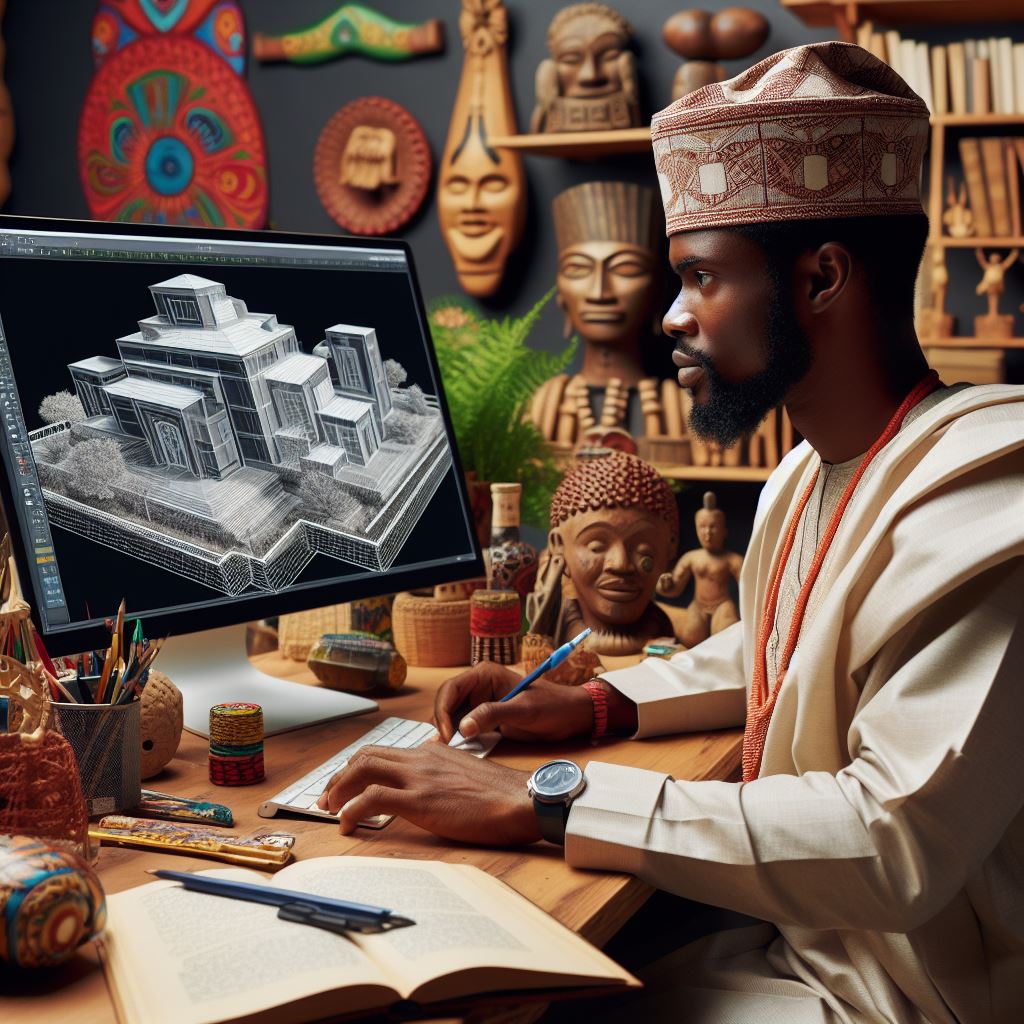Introduction
3D modeling is the process of creating a three-dimensional representation of a physical object or scene.
It is an essential tool in various industries, such as film and animation, architecture, gaming, and product design.
With 3D modeling, designers can bring their ideas to life, allowing for better visualization and communication of concepts.
Moreover, 3D modeling enables the creation of realistic and accurate virtual prototypes, saving time and resources in the product development process.
It plays a crucial role in architectural visualization, as it allows architects to showcase their designs and simulate how buildings will look and function.
The applications of 3D modeling are not limited to just the creative industries – it is also used in medical imaging, geospatial mapping, and even crime scene reconstruction.
Given the wide range of applications, there is a growing demand for individuals with 3D modeling skills in the job market.
Companies are increasingly seeking professionals who can create immersive virtual experiences and design realistic, visually appealing products.
Whether you aspire to work in visual effects, game development, or industrial design, learning 3D modeling opens up a world of opportunities.
We will explore the fundamentals of 3D modeling, the tools and software used, and how to get started on your journey into the world of three-dimensional design.
Getting Started with 3D Modeling
Are you ready to dive into the exciting world of 3D modeling? Whether you’re interested in creating stunning visual effects for movies or designing intricate architectural structures, 3D modeling is a valuable skill to have.
We will provide an overview of essential software and tools for 3D modeling and introduce you to popular 3D modeling software like Blender, AutoCAD, and SketchUp. Let’s get started!
Overview of Essential Software and Tools for 3D Modeling
- Computer: To get started with 3D modeling, you’ll need a reliable computer with good processing power and graphics capabilities.
- Operating System: Most 3D modeling software is compatible with Windows, macOS, and Linux, so choose an operating system that suits your needs.
- Graphics Card: A powerful graphics card is essential for rendering realistic 3D models and handling complex simulations.
- 3D Modeling Software: There are numerous software options available for 3D modeling, and each has its strengths and specialties.
- Input Devices: You’ll need input devices like a mouse, keyboard, and graphics tablet to control and manipulate your 3D models.
Introduction to Popular 3D Modeling Software
Now, let’s take a closer look at some of the most popular 3D modeling software:
- Blender: Blender is a versatile open-source software that is free to use. It offers a wide range of features for modeling, animation, and rendering.
- AutoCAD: AutoCAD is widely used in the architecture and engineering industries. It provides powerful tools for precise 3D modeling and architectural design.
- SketchUp: SketchUp is a user-friendly software that is popular among beginners and hobbyists. It allows for quick and intuitive 3D modeling.
Choosing the Right Software Based on Personal Interests and Goals
When selecting the right 3D modeling software for you, consider your personal interests and goals:
- Industry Focus: Different software may be more suitable for specific industries, such as film, gaming, or architecture.
- Features and Functionality: Evaluate the features and functionality offered by each software to ensure they align with your desired projects.
- Learning Curve: Consider the learning curve associated with each software. Some may have steeper learning curves but offer advanced capabilities.
- Community and Support: Research the software’s community and available support to ensure you have access to resources and assistance when needed.
Remember, learning 3D modeling is an ongoing process. Don’t be afraid to explore different software options, experiment with different techniques, and seek inspiration from other artists.
The key is to practice consistently and never stop learning. Happy modeling!
Read: Java for Nigerian Developers
Personalized Financial Consulting – Tailored for You
Get a custom financial plan made just for you in 1-3 days. Clear strategies, actionable steps, and unlimited revisions.
Get StartedLearning 3D Modeling
When it comes to 3D modeling, learning the basics and building a strong foundation is crucial.
Without a solid understanding of the fundamentals, it becomes challenging to create complex and realistic models.
Here are some key points to keep in mind while learning 3D modeling:
Importance of learning the basics and building a strong foundation
- Mastering the basics sets the stage for advanced techniques and complex projects.
- Understanding key concepts like shape, form, and texture lays a solid groundwork for creating realistic models.
- Learning the basics helps in troubleshooting and identifying issues that may arise during the modeling process.
Available resources for learning 3D modeling
- Online courses: Platforms like Udemy, Coursera, and Skillshare offer a wide range of 3D modeling courses.
- Tutorials: Websites like YouTube and Autodesk Learning Hub provide free tutorials for beginners and advanced users.
- Books: Many comprehensive books are available, such as “3D Modeling for Beginners” by Steve Nunez and “Polygonal Modeling: Basic and Advanced Techniques” by Mario Russo.
Tips and strategies for effectively learning 3D modeling
- Set specific goals and prioritize what you want to learn, whether it’s character modeling, product visualization, or architectural design.
- Practice regularly, dedicating a certain amount of time each day or week to hone your skills.
- Break down complex projects into smaller tasks to avoid feeling overwhelmed and to track your progress.
- Join online communities and forums to connect with other 3D artists, ask questions, and receive feedback on your work.
- Experiment with different software and tools to find the ones that best suit your workflow and artistic style.
Importance of practice and continuous improvement
Like any skill, practice is essential for becoming proficient in 3D modeling. Here’s why:
- Consistent practice helps improve your speed and efficiency in creating models.
- Practice allows you to explore different techniques and experiment with various styles.
- Mistakes are valuable learning opportunities. Embrace them, learn from them, and keep pushing yourself to improve.
- Continuously seeking feedback and critiques from others can help you identify areas for improvement and refine your skills.
- Staying up-to-date with the latest trends and advancements in the industry ensures your skills remain relevant and competitive.
Remember, learning 3D modeling is a journey that requires dedication, patience, and a passion for the craft. It’s an art form that allows you to bring your imagination to life in a digital realm.
So start today, follow the tips mentioned above, and embark on an exciting creative adventure!
Read: Python for Data Analysis
Mastering 3D Modeling Techniques
When it comes to 3D modeling, various techniques can be utilized to bring your creative visions to life.
Understanding these techniques and continuously improving your skills is essential to becoming a proficient 3D modeler.
Understanding Different 3D Modeling Techniques
One of the fundamental aspects of mastering 3D modeling is understanding the different techniques available. Two prominent techniques include polygonal modeling and NURBS modeling.
- Polygonal modeling involves creating 3D models using interconnected polygons, forming the basic structure of the object. It is widely used and offers versatility in creating both organic and inorganic models.
- NURBS modeling, on the other hand, stands for Non-Uniform Rational B-splines. It allows for the creation of complex and smooth surfaces by using mathematical representations. NURBS modeling is particularly useful when precision and accuracy are required.
Advanced 3D Modeling Techniques
Once you have a grasp on the basics, it’s time to delve into advanced 3D modeling techniques to take your skills to the next level. Here are two techniques worth exploring:
- Sculpting enables artists to mold and shape virtual clay, similar to traditional sculpting methods. It provides a more intuitive approach to modeling organic forms and is widely used in character development and environmental design.
- Organic modeling focuses on creating lifelike and natural objects such as animals, plants, and human characters. It involves paying attention to details like anatomy, proportion, and gestures to achieve realism.
Participating in Workshops, Seminars, and Conferences to Enhance Skills
Continuous learning and skill enhancement are crucial in the field of 3D modeling. One effective way to achieve this is by participating in workshops, seminars, and conferences.
These events provide opportunities to learn from industry experts, gain insights into the latest techniques and trends, and network with fellow 3D modelers.
They also offer a platform to showcase your work and receive valuable feedback for improvement.
Collaborating with Other 3D Modelers and Joining Online Communities
Collaboration and community engagement play a significant role in honing your 3D modeling skills.
Joining online communities allows you to connect with like-minded individuals, share knowledge, and get inspired by the work of others.
In addition, collaborating with other 3D modelers provides unique learning opportunities. It allows for the exchange of ideas, feedback, and techniques, fostering growth and pushing boundaries in your work.
Remember, 3D modeling is a constantly evolving field, and staying up to date with the latest techniques and tools is vital to your success.
Continuously learn, practice, and explore different avenues to reach new heights in your 3D modeling journey.
Read: Big Data: A Nigerian Perspective
Building a Strong Portfolio
A well-crafted portfolio is essential for showcasing 3D modeling skills and attracting potential clients and job opportunities.
Here are key considerations for creating an impactful portfolio:
Unlock Your Path to Financial Freedom
Personalized savings and investment strategies tailored to your financial goals. Let's help you take control of your future with a plan designed just for you.
Get Started- Importance of a Well-Presented Portfolio: Your portfolio visually represents your abilities and expertise and Provides a glimpse of your work to potential clients and employers.
- Choosing the Right Projects: Select projects aligning with your career goals and Highlight skills in various areas of 3D modeling.
- Demonstrating Versatility: Include diverse projects like product designs, architectural models, and character designs.
- Showcasing Your Best Work: Feature your strongest and most relevant pieces and Make a lasting impression on potential clients.
- Organizing Your Portfolio: Structure it logically for easy navigation and Categorize work based on project type or industry.
- Providing Project Details: Include client information, your role, and noteworthy aspects and Help potential clients understand your experience and specific skills.
- Using High-Quality Visuals: Ensure images and renderings are of the highest quality Poor visuals can detract from your work and evaluation by clients.
- Seeking Feedback: Before finalizing, seek input from trusted colleagues or professionals and Incorporate valuable insights to enhance presentation and content.
- Maintaining an Online Presence: Create an online portfolio or website for a wider audience and Include the link in your resume and social media profiles.
- Updating Regularly: Keep the portfolio current by adding new projects and removing older ones Demonstrate commitment to growth and keep it relevant.
In the competitive world of 3D modeling, a strong portfolio is a powerful tool that opens doors to new opportunities.
Investing time in crafting a well-presented portfolio allows you to effectively showcase skills, attract clients, and propel your career to new heights.
Finding Opportunities in 3D Modeling
When it comes to 3D modeling, numerous career paths offer exciting opportunities. Whether you’re passionate about architecture, film, animation, or video games, this field has something for everyone.
Here, we’ll explore how you can find these opportunities and make the most of them.
Overview of Potential Career Paths in 3D Modeling
- Architecture: Many architects rely on 3D modeling to bring their designs to life and create realistic representations of buildings.
- Film and Animation: From visual effects in movies to character modeling in animated films, 3D modeling plays a crucial role in the entertainment industry.
- Video Games: The gaming industry heavily relies on 3D modeling for creating virtual worlds, characters, and objects.
By identifying your interests and aligning them with a specific career path, you can focus your efforts in that direction.
Building a Professional Network and Connections
In any field, networking is key, and 3D modeling is no exception. By building a strong professional network, you open doors to potential job opportunities and collaborations.
Here are a few ways you can do this:
- Attend industry events and conferences to meet professionals in the field.
- Join online communities and forums where you can connect with fellow 3D modelers.
- Utilize social media platforms like LinkedIn to showcase your work and connect with potential clients or employers.
Remember, networking is all about building genuine relationships, so don’t be afraid to reach out and engage with others in the industry.
Utilizing Online Platforms and Job Boards for Finding Freelance or Remote Work
The internet has made it easier than ever to find freelance or remote work in 3D modeling.
There are several platforms and job boards specifically tailored to creative industries, including 3D modeling. Some popular platforms include:
- Upwork: A freelancing platform where you can find numerous 3D modeling gigs and projects.
- ArtStation: A community-driven platform that showcases artists’ portfolios and allows them to find job opportunities.
- Freelancer: Similar to Upwork, Freelancer offers a wide range of 3D modeling projects for freelancers.
By creating a profile on these platforms and actively searching for relevant projects, you can find consistent freelance work or even secure remote positions with established companies.
Starting a 3D Modeling Business or Offering Services as a Freelancer
If you’re looking to take your 3D modeling skills to the next level, starting your own business or offering services as a freelancer is an excellent option.
Here are a few steps to get started:
- Define your niche: Determine your specialty or the specific industries you want to cater to.
- Create a portfolio: Showcase your best work to potential clients to demonstrate your skills and expertise.
- Set competitive pricing: Research the market rates for 3D modeling services and develop a pricing strategy.
- Market your services: Utilize social media, your website, and online communities to promote your business and attract clients.
Starting your own business or freelancing allows you to have full control over your work and potential income. However, keep in mind that it requires self-discipline and effective marketing to succeed.
Therefore, 3D modeling offers a wide range of opportunities in various industries.
By actively seeking out these opportunities, building a strong network, and utilizing online platforms, you can pave the way for a successful career in this exciting field.
Read: Cybersecurity Skills in Demand

Monetizing 3D Modeling Skills
For 3D modelers seeking profit, explore monetization avenues. Learn pricing, and negotiation, and stay updated on industry trends.
Different Avenues for Monetizing 3D Modeling Skills
- Freelancing: Join online platforms like Upwork or Freelancer to offer your services to clients worldwide.
- Commissioned Work: Collaborate with artists, architects, or game developers to create custom 3D models.
- Stock Marketplaces: Sell your pre-made 3D models on websites like TurboSquid, CGTrader, or Unity Asset Store.
- Educational Resources: Create and sell tutorials, courses, or eBooks to help others learn 3D modeling.
- Virtual Reality (VR): Develop immersive VR experiences and offer them to businesses or individuals.
Pricing Strategies for 3D Modeling Services
- Hourly Rate: Calculate your base rate by considering factors like experience, complexity, and market demand.
- Flat Fee: Set a fixed price for specific types of projects, such as product modeling or architectural visualization.
- Package Pricing: Offer different packages with varying levels of detail and customization options.
- Licensing: Sell licenses for your 3D models, allowing clients to use them in their projects.
- Revenue Share: Collaborate with game developers or filmmakers and earn a percentage of the final product’s sales.
Negotiating Contracts and Dealing with Clients
- Clearly Define Scope: Set detailed project requirements and deliverables to avoid misunderstandings.
- Estimate Timelines: Provide accurate timeframes and milestones to manage client expectations.
- Agree on Revisions: Establish the number of revisions included in the contract and any additional costs.
- Protect Your Work: Include clauses on intellectual property rights and usage permissions.
- Communication is Key: Maintain open and transparent communication with your clients throughout the project.
Importance of Staying Updated with Industry Trends and Advancements
In a rapidly evolving field like 3D modeling, staying updated is crucial for success and competitiveness.
Here’s why:
- Emerging Technologies: Keep abreast of new tools, software, and techniques to stay ahead of the curve.
- Client Demand: Understand market trends to offer in-demand services and cater to client preferences.
- High-Quality Standards: Continuously improve your skills to deliver top-notch models that meet industry standards.
- Networking Opportunities: Attend conferences, and workshops, or join online communities to connect with industry professionals and potential clients.
- Inspiration and Innovation: Learning from others and staying informed sparks creativity and enhances your work.
By exploring different avenues, implementing effective pricing strategies, mastering negotiation skills, and staying updated with industry trends, you can turn your 3D modeling skills into a lucrative career.
Remember, success comes with continuous learning and adapting to the dynamic landscape of the 3D modeling industry.
Take Control of Your Debt Today
Struggling with debt? Get personalized strategies to pay off your debts, negotiate with creditors, and rebuild your credit. Your path to financial freedom starts here.
Get HelpConclusion
In the end, 3D modeling offers numerous benefits and endless possibilities. It allows you to bring your ideas to life, create realistic visualizations, and improve design accuracy.
With 3D modeling, you can streamline production processes, reduce costs, and showcase your products compellingly and interactively.
If you’ve been contemplating starting your journey in 3D modeling, now is the time to take that leap. Don’t let the initial learning curve deter you.
With the abundance of tutorials and resources available, you can quickly grasp the fundamentals and gradually advance your skills.
Start your 3D modeling journey today to unlock countless opportunities.
Whether you’re a designer, architect, engineer, or a creative mind, it revolutionizes project approaches and unleashes limitless imagination.
Remember, the path to mastery may not be easy, but it’s worth it. Embrace challenges, experiment with new techniques, and always strive for improvement.
Your dedication and commitment will pay off, and soon you’ll be amazed at what you can achieve in the exciting realm of 3D modeling.
Start today and embark on a thrilling adventure that will transform how you view the world of design.




